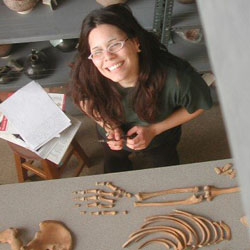Digging Deep: Jennifer Suarez '09 Uncovers History in Peru

Details
Over several weeks this summer, Jennifer Suarez '09 has climbed mountains, been detained during a political blockade, gotten over 30 mosquito bites, gone more than four days without showering, excavated and cleaned countless human and animal bones, and purchased a dog for $4.
It's all part of her internship with a team of researchers and anthropologists working on the Andahuaylas BioArchaeological Project in the city of Andahuaylas (pronounced: Ahn-da-WHY-las), Peru, which she has renamed“the land of magical realism” for its surreal beauty and thrilling unpredictability. The project has enabled her to take part in a myriad of tasks, which include establishing a museum, building bridges, rescuing remains from looted caves, and smuggling mummy bundles into the hospital to be X-rayed.
Suarez is working with the team under the auspices of Haverford's Center for Peace and Global Citizenship, which has funded 50 students this summer to work for peace at home and abroad.
The archaeological aspect of her internship involves excavating bone and ceramic remains of the Chanka society, which came to a violent end in 1400 as a result of imperial disintegration, from mortuary sites near Andahuaylas. Suarez and her team hope to learn about the nature of physical violence inflicted upon individuals, particularly the weaponry used, the populations affected by violence, and the ways violence transpired within a cross-cultural context.
Her fieldwork centers in San Antonio de Cachi, a village located in the upper southwestern reaches of the Valley of Andahuaylas. She also spends time analyzing the remains in a laboratory in the suburb of Talavera. Her team includes Project House Manager Virginia Smith BMC '07, Project Director Emmanuel Gomez, Co-Director Danielle Kurin BMC '05, Sarah Bechdel BMC '10, and Angely Mondestine '10.
While Suarez, an anthropology major, does not aim to be an archaeologist, her“passion,” she says,“lies in analyzing what has been pulled out of the ground, mainly human remains, and searching for traumas, pathologies, and congenital conditions from older times.” Her personal task involves analyzing dental remains to discover differences between ancient and modern treatments, infections, and dietary habits.
On the cultural side of her mission, Suarez is helping establish an anthropological museum in Andahuaylas based out of the BioArchaeological Project's new laboratory. The original municipal museum, located in a tiny room at the back of a children's library, had gone unused because its owner refused to open it to the public. Its new location will place it at the hub of activity, in the storage area of a monumental stadium situated between two large schools. Even though the museum has not yet been inaugurated, more than 50 visitors a day have been coming to it, says Suarez.
“I have put all that I have learned as an anthropology major to the test,” she says. The project has refined her skills in studying the structure and function of bones, given her access to traumatic stories in other cultures, and immersed her, she says,“in another part of the world whose people are in need of help and friendship.”
Inspired to return to Peru after doing similar research there two years ago, Suarez is also disentangling cultural differences.“Up in the country, in Cachi, I love that I can spend the morning and afternoon excavating in the mountains and then come into town and relax with the children, who are incredibly curious abut American culture, as are their parents,” she says.
—Nicole Gervasio BMC '10



